Body contouring after major weight loss improves the shape and tone of your underlying tissue that supports fat and skin and removes excess, sagging fat and skin.
Table of Contents
- Why Body Contouring Surgery?
- What to expect during your consultation
- Important facts about the safety and risks of body contouring surgery
- My recovery
- The results will be long-lasting
- How much will body contouring surgery cost?
- Words to know
Why Body Contouring Surgery?
Enhancing your appearance with body contouring surgery
Following weight reduction surgery, or any substantial amount of weight loss, the skin and tissues often lack elasticity and cannot conform to the reduced body size. As a result, skin that has been severely stretched now is unsupported:
- Upper arms may sag and appear loose and full
- Breasts may flatten and hang with nipples pointed downward
- Abdominal area may extend around the sides and into the lower back area, resulting in an apron-like overhang
- Buttocks, groin and thighs can sag and cause hanging pockets of skin
Surgical body contouring following major weight loss improves the shape and tone of your underlying tissue that supports fat and skin, and removes excess sagging fat and skin.
The result is a more normal appearance to the body, with smoother contours. This is, in essence, the final phase of your total weight loss experience.
Is it right for me?
Before you decide to undergo body contouring following major weight loss, your weight loss must be stabilized.
- If you continue to lose weight, sagging pockets will redevelop.
- If you rapidly regain the weight, you will traumatically stress your already weakened and thinned skin, causing further stress to the skin, visible stretch marks and wide scars.
If you had weight reduction surgery, your plastic surgeon will work closely with your physician to determine when it is appropriate for you to begin body contouring.
Good candidates for body contouring are:
- Adults of any age whose weight loss has stabilized
- Healthy individuals who do not have medical conditions that can impair healing or increase risk of surgery
- Non-smokers
- Individuals with a positive outlook and realistic goals for what body contouring can accomplish
- Individuals committed to leading a healthy lifestyle including proper nutrition and fitness
Procedural Steps:
What happens during body contouring surgery?
The procedures necessary to achieve your goals will be defined along with a plan for the timing of these procedures. Plastic surgery procedures that may be recommended by your physician include:
- Lower body lift: to correct sagging of the abdomen, buttocks, groin and outer thighs
- Breast lift: to correct sagging, flattened breasts
- Arm lift: to correct sagging of the upper arms
- Thigh lift: to correct sagging of the inner, outer and mid thigh
Step 1 – Anesthesia
Medications are administered for your comfort during the surgical procedures. The choices include intravenous sedation and general anesthesia. Your doctor will recommend the best choice for you.
Step 2 – The incision
All body contouring procedures require incisions to remove excess skin. In many cases, these incisions may be extensive.
Incision length and pattern depend on the amount and location of excess skin to be removed, as well as personal preference and your doctor’s surgical judgment.
Advanced techniques usually allow incisions to be placed in strategic locations where they can be hidden by most types of clothing, but this is not always the case.
Body contouring is often performed in stages. Your particular condition and goals, as well as your plastic surgeon’s best judgment, will all influence how your doctor defines a surgical plan. While it may have taken you two years or more to lose all the excess weight, it may take equally as long for the results of your body contouring to be complete.
Body Lift
A complete lower body lift treats sagging buttocks, abdomen, waist, hips and outer thighs in one procedure or in staged procedures. Incision patterns vary, and may include a circumferential incision around the body to remove the “belt” of excess skin and fat.
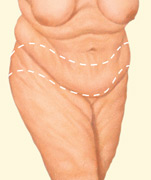
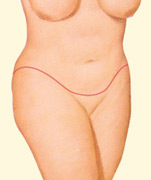
Breast Lift
The incision patterns for lifting a woman’s sagging breasts will be determined based on the amount of excess skin to be removed.
These may include one or a combination of incisions in a circular pattern around the areola, in a line extending from the areola to the breast crease, and horizontally along the breast crease.
A breast implant also may be recommended to enhance breast shape and size.
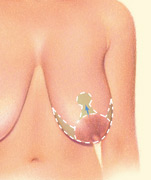
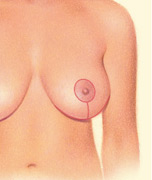
Arm Lift
Sagging skin in the upper arms is treated with an incision from the underarm area extending along the inside or back of the upper arm. Additional incisions on the arms may be necessary anywhere excess skin has formed sagging pockets.
The smoother, tighter contours that result from upper arm contouring are apparent almost immediately, although initially obscured by swelling and bruising. In addition, skin quality is dramatically improved in both appearance and texture.

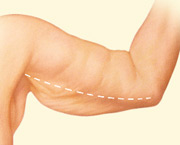
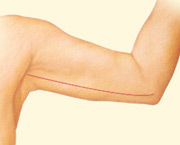
Thigh Lift
Reshaping of the thighs is achieved through incisions in the groin that can extend downward to the knee along the inner portion of the thigh.
Improving contours of the outer thigh may require an incision extending from the groin around the hip. Through these incisions your plastic surgeon will tighten tissues for a smoother, better toned thigh.

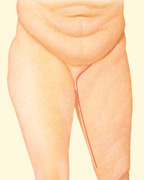
Important facts about the safety and risks of body contouring Surgery
The decision to have body contouring surgery is extremely personal and you’ll have to decide if the benefits will achieve your goals and if the risks and potential complications are acceptable.
Your plastic surgeon and/or staff will explain in detail the risks associated with surgery. You will be asked to sign consent forms to ensure that you fully understand the procedure you will undergo and any risks and potential complications.
Possible risks of body contouring following major weight loss include:
- Unfavorable scarring
- Bleeding (hematoma)
- Infection
- Fluid accumulation
- Poor wound healing
- Skin loss
- Blood clots
- Numbness or other changes in skin sensation
- Anesthesia risks
- Skin discoloration and/or prolonged swelling
- Fatty tissue found deep in the skin might die (fat necrosis)
- Major wound separation
- Asymmetry
- Recurrent looseness of skin
- Pain, which may persist
- Deep vein thrombosis, cardiac and pulmonary complications
- Persistent swelling in the legs
- Possibility of revisional surgery
My recovery
After your body contouring procedure is completed, dressings or bandages will be applied to the incisions. A small, thin tube may be temporarily placed under the skin to drain any excess blood or fluid that may collect.
You will be given specific instructions that may include: How to care for your surgical site(s) following surgery, medications to apply or take orally to aid healing and reduce the risk of infection, specific concerns to look for at the surgical site or in your general health, and when to follow-up with your plastic surgeon.
When you go home
If you experience shortness of breath, chest pains, or unusual heart beats, seek medical attention immediately. Should any of these complications occur, you may require hospitalization and additional treatment.
The practice of medicine and surgery is not an exact science. Although good results are expected, there is no guarantee. In some situations, it may not be possible to achieve optimal results with a single surgical procedure and another surgery may be necessary.
Be careful
Following your physician’s instructions is key to the success of your surgery. It is important that the surgical incisions are not subjected to excessive force, abrasion, or motion during the time of healing. Your doctor will give you specific instructions on how to care for yourself.
The results will be long-lasting
The results of body contouring following aggressive weight loss are visible almost immediately.
However, it may take as many as one to two years or more for the final results of all the recommended body contouring procedures to fully develop. Visible scars will remain, but the overall results are long-lasting, provided that you maintain a stable weight and general fitness.
As your body ages, it is natural to lose some firmness. However, most of your initial improvement should be relatively permanent.
How much will body contouring surgery cost?
Cost is always a consideration in elective surgery. Prices for body contouring procedures can vary widely.
A surgeon’s cost for body contouring procedures may vary based on his or her experience, the type of procedure used, as well as geographic office location.
Many plastic surgeons offer patient financing plans, so be sure to ask.
Cost may include:
- Surgeon’s fee
- Hospital or surgical facility costs
- Anesthesia fees
- Prescriptions for medication
- Post-surgery garments, and
- Medical tests
Words to know
- Areola: Pigmented skin surrounding the nipple.
- Arm lift: A surgical procedure, also known as brachioplasty, to correct sagging of the upper arms.
- Breast implants: Medical device placed in your body to enhance an existing breast size or to reconstruct your breast. Breast implants can be filled with either salt water (saline) or silicone (elastic gel).
- Breast lift: Also known as mastopexy, surgery to lift the breasts.
- Breast contouring: A surgical procedure following massive weight loss to improve shape and tone and remove excess fat and skin.
- Circumferential incision: A surgical incision around the body to remove the “belt” of excess skin and fat and additional incisions that may resemble a bikini bottom pattern.
- General anesthesia: Drugs and/or gases used during an operation to relieve pain and alter consciousness.
- Hematoma: Blood pooling beneath the skin.
- Intravenous sedation: Sedatives administered by injection into a vein to help you relax.
- Local anesthesia: A drug injected directly to the site of an incision during an operation to relieve pain.
- Lower body lift: Surgical procedure to correct sagging of the abdomen, buttocks, groin and outer thighs.
- Macerated skin: Excess skin that hangs and becomes wet or infected underneath.
- Medial thigh lift: A surgical procedure to correct sagging of the inner thigh.
- Outer thigh lift: A surgical procedure to correct sagging of the outer and mid-thigh.
- Sutures: Stitches used by surgeons to hold skin and tissue together.
